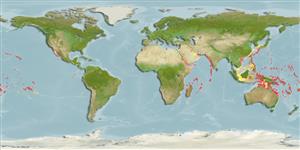|
Diadematoida |
Diadematidae
Environment: milieu / climate zone / depth range / distribution range
экология
ассоциированный с рифами; пределы глубины 1 - 40 m (Ref. 800). Tropical
Indo-Pacific: from Indian Ocean to Tahiti and from Japan to South Pacific Islands.
Length at first maturity / Size / Вес / Возраст
Maturity: Lm ? range ? - ? cm Max length : 20.0 cm WD самец/пол неопределен; (Ref. 87895)
Occurs in shallow coral and coral rubble areas at depths of 1 to 40 m (Ref. 81254), coral reefs and sandy areas (Ref. 129602). A generalist herbivore displaying nocturnal feeding behavior (Ref. 81254). Known to graze (Also Ref. 129602) on organic material and adults may also feed on live hard corals. Sometimes associated with commensal shrimp Stegopontonia commensalis (Ref. 800). Commonly found with Diadema spp. Bioeroder. Feeds on small and turf algae over hard substrates (Ref. 129602).
Life cycle and mating behavior
половая зрелость | размножение | нерест | икра | Fecundity | личинки
Members of the class Echinoidea are gonochoric. Fertilization is external. Brooding is common, eggs are held either on the peristome, around the periproct or deep into the concavities on the petaloids. Life cycle: Embryos develop into planktotrophic larvae (echinoplateus) and live for several months before they sink to the bottom using their tube feet to adhere on the ground where they metamorphose into young urchins.
Основная ссылка
ссылки | координатор | соавторы
Schoppe, S. 2000. (Ref. 800)
Статус Красного Списка МСОП (Ref. 130435)
Статус СИТЕС (Ref. 108899)
Not Evaluated
Not Evaluated
Угроза для людей
Использование человеком
рыболовство: коммерческий
| FishSource | Sea Around Us
инструменты
дополнительная информация
Возраст/РазмерыростЗависимость между длиной и массой телаЗависимость между длинамиморфологияличинкичисленность
ресурсы в Интернет
Estimates based on models
Preferred temperature
(Ref.
115969): 24.7 - 28.9, mean 27.5 (based on 362 cells).
Категория цены
Unknown.
Nutrients: Calcium = 126 [75, 177] mg/100g; Iron = 5.08 [1.67, 7.92] mg/100g; Protein = 12%; Omega3 = 0.331 [0.263, 0.400] g/100g; Selenium = 0.04 [48.48, 67.17] μg/100g; VitaminA = 0 μg/100g; Zinc = 1.97 [0.92, 3.02] mg/100g (wet weight).
